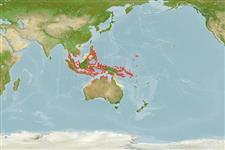Environment: milieu / climate zone / profondeur / distribution range
Écologie
marin récifal; profondeur 1 - 5 m (Ref. 90102). Tropical; 20°N - 28°S, 94°E - 168°E
Western Central Pacific: Indo-Malay Archipelago to Solomon Islands.
Taille / Poids / Âge
Maturité: Lm ? range ? - ? cm
Max length : 6.5 cm TL mâle / non sexé; (Ref. 48635)
Description synthétique
Clés d'identification | Morphologie | Morphométrie
Épines dorsales (Total) : 8; Rayons mous dorsaux (Total) : 9; Épines anales: 2; Rayons mous anaux: 8.
Body shape (shape guide): elongated; Cross section: oval.
Found in shallow coral reefs around lagoons and sheltered bays (Ref. 36661). In small groups, usually sheltering near long-spined urchins or large anemones in seagrasses (Ref. 48635).
Life cycle and mating behavior
Maturité | Reproduction | Frai | Œufs | Fécondité | Larves
Mouthbrooders (Ref. 240). Distinct pairing during courtship and spawning (Ref. 205).
Allen, G.R., 1997. The marine fishes of tropical Australia and south-east Asia. Western Australian Museum, Perth, Western Australia. 292 p. (Ref. 36661)
Statut dans la liste rouge de l'IUCN (Ref. 130435: Version 2025-1)
Menace pour l'homme
Harmless
Utilisations par l'homme
Outils
Articles particuliers
Télécharger en XML
Sources Internet
Estimates based on models
Preferred temperature (Réf.
123201): 26.5 - 29.3, mean 28.8 °C (based on 2158 cells).
Phylogenetic diversity index (Réf.
82804): PD
50 = 0.5000 [Uniqueness, from 0.5 = low to 2.0 = high].
Bayesian length-weight: a=0.00550 (0.00223 - 0.01355), b=3.27 (3.06 - 3.48), in cm total length, based on LWR estimates for this (Sub)family-body shape (Ref.
93245).
Niveau trophique (Réf.
69278): 3.4 ±0.4 se; based on size and trophs of closest relatives
Résilience (Réf.
120179): Haut, temps minimum de doublement de population inférieur à 15 mois (Preliminary K or Fecundity.).
Fishing Vulnerability (Ref.
59153): Low vulnerability (10 of 100).
🛈
